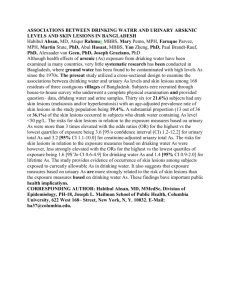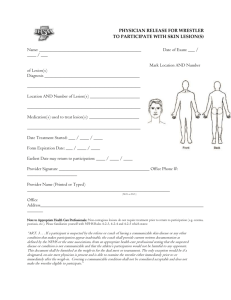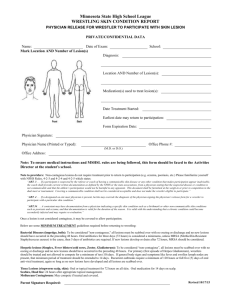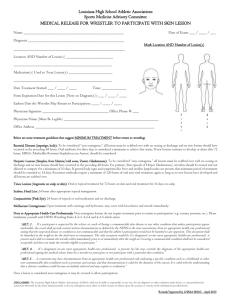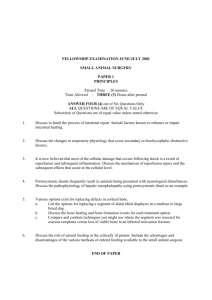Asymptomatic radiopaque lesions of the jaws
advertisement
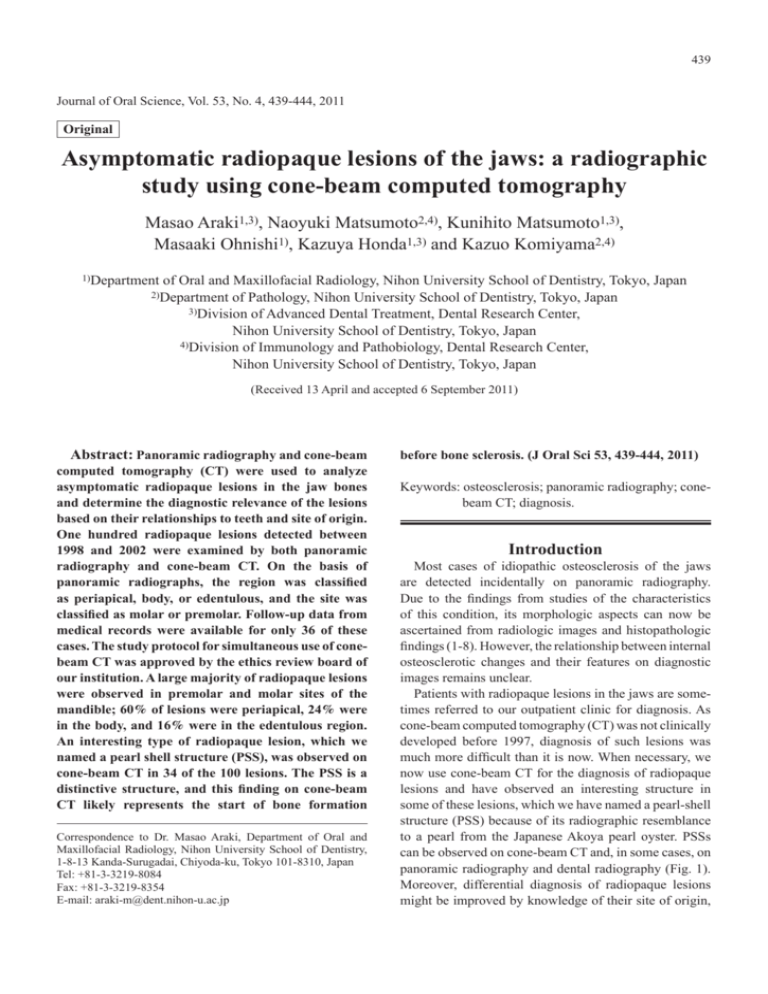
439 Journal of Oral Science, Vol. 53, No. 4, 439-444, 2011 Original Asymptomatic radiopaque lesions of the jaws: a radiographic study using cone-beam computed tomography Masao Araki1,3), Naoyuki Matsumoto2,4), Kunihito Matsumoto1,3), Masaaki Ohnishi1), Kazuya Honda1,3) and Kazuo Komiyama2,4) 1)Department of Oral and Maxillofacial Radiology, Nihon University School of Dentistry, Tokyo, Japan of Pathology, Nihon University School of Dentistry, Tokyo, Japan 3)Division of Advanced Dental Treatment, Dental Research Center, Nihon University School of Dentistry, Tokyo, Japan 4)Division of Immunology and Pathobiology, Dental Research Center, Nihon University School of Dentistry, Tokyo, Japan 2)Department (Received 13 April and accepted 6 September 2011) Abstract: Panoramic radiography and cone-beam computed tomography (CT) were used to analyze asymptomatic radiopaque lesions in the jaw bones and determine the diagnostic relevance of the lesions based on their relationships to teeth and site of origin. One hundred radiopaque lesions detected between 1998 and 2002 were examined by both panoramic radiography and cone-beam CT. On the basis of panoramic radiographs, the region was classified as periapical, body, or edentulous, and the site was classified as molar or premolar. Follow-up data from medical records were available for only 36 of these cases. The study protocol for simultaneous use of conebeam CT was approved by the ethics review board of our institution. A large majority of radiopaque lesions were observed in premolar and molar sites of the mandible; 60% of lesions were periapical, 24% were in the body, and 16% were in the edentulous region. An interesting type of radiopaque lesion, which we named a pearl shell structure (PSS), was observed on cone-beam CT in 34 of the 100 lesions. The PSS is a distinctive structure, and this finding on cone-beam CT likely represents the start of bone formation Correspondence to Dr. Masao Araki, Department of Oral and Maxillofacial Radiology, Nihon University School of Dentistry, 1-8-13 Kanda-Surugadai, Chiyoda-ku, Tokyo 101-8310, Japan Tel: +81-3-3219-8084 Fax: +81-3-3219-8354 E-mail: araki-m@dent.nihon-u.ac.jp before bone sclerosis. (J Oral Sci 53, 439-444, 2011) Keywords: osteosclerosis; panoramic radiography; conebeam CT; diagnosis. Introduction Most cases of idiopathic osteosclerosis of the jaws are detected incidentally on panoramic radiography. Due to the findings from studies of the characteristics of this condition, its morphologic aspects can now be ascertained from radiologic images and histopathologic findings (1-8). However, the relationship between internal osteosclerotic changes and their features on diagnostic images remains unclear. Patients with radiopaque lesions in the jaws are sometimes referred to our outpatient clinic for diagnosis. As cone-beam computed tomography (CT) was not clinically developed before 1997, diagnosis of such lesions was much more difficult than it is now. When necessary, we now use cone-beam CT for the diagnosis of radiopaque lesions and have observed an interesting structure in some of these lesions, which we have named a pearl-shell structure (PSS) because of its radiographic resemblance to a pearl from the Japanese Akoya pearl oyster. PSSs can be observed on cone-beam CT and, in some cases, on panoramic radiography and dental radiography (Fig. 1). Moreover, differential diagnosis of radiopaque lesions might be improved by knowledge of their site of origin, 440 a b c d Fig. 1 a . Panoramic radiograph shows a radiopaque lesion in the body of the right lower premolar site of the mandible. b, c, d. Cone-beam CT images (b: parallel section, c: cross-section, d: horizontal section). The radiopacity of the lesion varies, and a central region with increased opacity is visible (pearl shell structure, PSS). These CT images clearly show the heterogeneous form of the PSS. a Fig. 2 S ites of radiopaque lesions detected on panoramic radiographs. particularly with regard to whether their origin is odontogenic or nonodontogenic. However, these factors are outside the scope of the present research. This retrospective study used panoramic radiography and cone-beam CT to analyze asymptomatic radiopaque lesions in jaw bones and determine the diagnostic relevance of PSSs, based on the site of origin of the lesions and their relationship with the teeth. Materials and Methods We examined 100 radiopaque lesions that had been revealed by panoramic radiography (imaging conditions: 70-75 kVp, 7-10 mA) between 1998 and 2002. First, we determined the characteristics of lesions by identifying their location on panoramic radiographs. Then, we obtained images of the lesions using a cone-beam CT device (3DX; Morita Corp, Kyoto, Japan; 85 kVp, 10 mA, and 17 s, with a total filtration of 1.2 mm Cu). All patients were given a detailed explanation of cone-beam CT. The study protocol for the use of cone-beam CT was approved in advance by our institution’s ethics review board. b c Fig. 3 Cone-beam CT images of PSSs in the periapical region of the right lower canine site of the mandible. These CT images clearly show a small homogeneous radiopaque spot in the central region. a: parallel section, b: cross-section, c: horizontal section The panoramic radiographs were used to classify the region of the lesions as periapical (in contact with the tooth root), body (within the mandible), or edentulous (in the edentulous alveolar bone) (Fig. 2). Cone-beam CT was then used in all cases to analyze radiopaque lesions and their contents. On cone-beam CT images, a PSS was defined as a small, more intense, radiopaque spot within a radiopaque lesion. Radiopaque regions that resembled an osteosclerotic mass were also included in the present study (Fig. 1). A PSS represents a wide range of possible lesions, but must be observable in at least two directions on cone-beam CT images, i.e., parallel (Fig. 3a), cross- (Fig. 3b), and horizontal (Fig. 3c) sections. Two experienced radiologists evaluated the cone-beam CT images and identified PSSs on randomly selected panoramic radiographs and cone-beam CT images. We reviewed the medical records of patients for whom follow-up data from medical records were available (36 of the 100 cases). Among these patients, we investigated the condition of adjacent teeth, including the need for dental treatment, pulp vitality, abrasion of the occlusal surface, and the presence of pain. 441 Table 1 Age and sex distribution of the patients Age Male Female 10-19 2 5 20-29 4 20 6 12 2 15 50-59 6 13 60-69 0 9 70-79 0 5 80-89 0 1 Total 20 cases 80 cases Non-PSS 96 66 n = 100, PSS: Pearl shell structure Cone beam CT: Cone-beam Computed Tomography Table 2 Distribution of radiopaque lesions in the jaw bones, and number of patients with pearl shell structures (PSSs) Premolar Molar Angle 1 3(1) 0 18(6) 14(11) 4(1) 31(9) 4 6(3) 1 2(1) 5 3 0 0 3 0 0 3(1) 1 1(1) 0 0 0 n = 100, ( ): Numbers of PSS P-region:Periapical region shows radiopaque lesions in contact with the tooth root B-region:Body region shows radiopaque lesions within the mandible E-region: Edentulous shows radiopaque lesions in edentulous alveolar bone Statistical analysis We used the chi-square test for independence to analyze the location of radiopaque lesions and the specific site within that region. We used the same test to evaluate the relationship between PSS site and the location of radiopaque lesion formation. Fisher’s exact probability test was used to evaluate the relationship between the presence of a PSS and dental attrition. A P value < 0.05 was considered to indicate statistical significance. Results PSS 4 34 Panoramic radiography Cone beam CT 40-49 Incisor Entitiy Method 30-39 Site Mandible P-region B-region E-region Maxilla P-region B-region E-region Table 3 Comparison of panoramic radiographs and images from cone-beam computed tomography (CT) The 100 lesions were found in 20 men and 80 women. The mean age of the patients was 41.9 years (range, 10–82 years; Table 1). Regarding the evaluation of panoramic radiographs, the most frequent sites of radiopaque lesions were the premolar and molar sites of the mandible. The region was classified as periapical in 60 cases, body in 24 cases, and edentulous in 16 cases (Table 2). A PSS was found in 34 of the 100 cases (34%), Table 4 Follow-up data from the clinical records of 23 patients with radiopaque lesions accompanied by a pearl shell structure Area A B C D P-region (n = 14) 7 12 7 0 B-region (n = 7) 4 5 6 0 E-region (n = 2) - - - 1 A: No dental treatment, B: Vital tooth, C: Abrasion, D: pain P-region: Periapical region shows radiopaque lesions in contact with the tooth root B-region: Body region shows radiopaque lesions within the mandible E-region: Edentulous region shows radiopaque lesions in edentulous alveolar bone and the mean age of these patients was 36.9 years. A PSS was most commonly found in the premolar and molar sites, particularly within body lesions at premolar sites and within periapical lesions at molar sites. Thus, PSSs tended to be located at a distance from the roots of teeth. In a comparison of panoramic radiographs and cone-beam CT images, the presence of a PSS could be confirmed by panoramic radiography alone in only 4 of the 34 cases (Table 3). Thirty-six patients with radiopaque lesions (including 23 with PSSs) were followed using information from clinical records. The condition of adjacent teeth was as follows: 11 patients did not need dental treatment, 17 showed pulp vitality, 13 had abrasions of occlusal surfaces, and 22 were free of pain (Table 4). We confirmed two PSS lesions histopathologically and found that these were caused by condensing osteomyelitis. One of these patients was a 14-year-old boy with the typical findings of a PSS on panoramic radiography (Fig. 4a). Histopathologically, the center of the PSS consisted of a mass of remodeling bone and was surrounded by wide, bony trabeculae and irregularly shaped, fibrous bone marrow (Fig. 4b). The chi-square test for independence showed a statistically significant association between the region of lesion formation and lesion site. However, PSS site was not 442 a b Fig. 4 a. Panoramic radiograph shows a radiopaque lesion with a PSS between the left lower canine and first premolar. b. Histopathologic image of a lesion resected at surgery shows that the center of the remodeling bone mass is surrounded by wide bone trabeculae and irregularly shaped fibrous bone marrow. significantly associated with the region of radiopaque lesion formation. Similarly, Fisher’s exact probability test showed no significant association between the presence of a PSS and dental attrition. Discussion Although the cause of most radiopaque lesions in the jaws is unclear, the etiologic factors for some of these lesions are gradually being discovered. Most radiopaque lesions are asymptomatic and are discovered incidentally on panoramic tomographs or on cone-beam CT images obtained during preoperative assessment of dental implants. These lesions can be benign tumors or reflect dysplastic or inflammatory changes, and can have complex imaging findings (9). Various terms have been used to describe such lesions, including idiopathic osteosclerosis (10-15), dense bone island (9,16,17), enostosis (18,19), focal periapical osteopetrosis (7), and condensing osteitis (20). In addition to their varying appearance, the size of these lesions can change in a number of ways (17). Not all asymptomatic radiopaque lesions are surgically removed soon after detection. Some are observed over a long period, which allows their behavior to be predicted. For these reasons, a comprehensive analysis of radiopaque lesions is not currently possible. In this study, we detected a small radiopaque mass within some of these radiopaque lesions. We noted this X-ray finding in the present study and refer to it as a pearl shell structure, or PSS. We initially thought that the PSS might be related to the formation of a radiopaque lesion within the bone. However, in the present study, we used cone-beam CT to examine 100 cases, and a PSS was found in only 34% of the cases. This suggests that a PSS is an indicator of the site where bone formation begins in the lesion. PSSs can be observed on cone-beam CT and are sometimes visible on intraoral and panoramic radiographs. In the present study, 4 of 34 cases with PSSs were confirmed by both panoramic and dental radiographs. The fact that these structures can be observed on plain radiography suggests that they are areas of the central bone that are undergoing bone sclerosis and therefore have higher radiographic density as compared with the surrounding bone lesion. Histopathologic examination of a completely resected lesion containing a PSS showed that the center of the remodeling bone mass was surrounded by wide bone trabeculae and irregularly shaped fibrous bone marrow (Fig. 4b). This particular case was caused by condensing osteomyelitis. Radiopaque lesions occurring in the periapical region can be neoplastic lesion or dysplastic lesion or inflammatory lesion (3). Therefore, it can be challenging to differentiate between a cement-like lesion derived from the odontogenic epithelium and an osteogenic lesion in the area around the dental root. We have previously described our experience regarding the site of occurrence and a variety of forms of jaw enostosis and have observed extensive overlap of the dental root by enostosis (18). Such areas of bone sclerosis around a tooth are usually diagnosed as odontogenic lesions. However, based on observation of tooth attrition, the present study found that many radiopaque lesions in the periapical region were caused by stimulus of occlusal disharmony without pain. Interestingly, radiopaque lesions with a PSS are often located in the body region, far from the apex of the dental root. These findings are perplexing. One possibility is that these lesions are a response to traumatic injury. Thus, as mentioned above, we believe that PSSs should be followed up to determine whether they are a starting point for bone sclerosis resulting from inflammation or a persistent focus of increasing bone sclerosis. The present findings offer new evidence regarding the regions of the jaw where radiopaque lesions occur. The most frequently involved regions were premolar and molar sites of the mandible; body lesions at premolar sites and periapical lesions at molar sites were particularly common. These findings require careful consideration. At a molar site, occlusal disharmony can cause hard-tissue formation along the periodontal space. At a premolar site, the body area of the mandible is not close to the dental root but is near the highly vascular mental foramen. Persistent, strong stimulus from occlusal disharmony could lead to bone sclerosis in the alveolar bone, which is suggested by the many cases of radiopaque lesions near the mental foramen. Another possible etiologic factor is that the premolar site of the mandible has a bowed configuration 443 and is continually subjected to internal stress (19,21). Internal and external stresses at the superficial aspect of the mandible need to be balanced to counteract stress from masticatory pressure and ensure positional stability of the mandible (19,21,22). However, these relationships are unclear in living organisms. Generally, mandibular tori and enostosis cannot occur simultaneously; however, these mechanisms are not well understood (19,21-28). In contrast, radiopaque lesions of odontogenic tumors arising from an adjacent tooth comprise a radiolucent area surrounded by a cortical rim, and endogenous PSSs do not appear to occur in this situation. Thus, we believe that the underlying mechanism of these lesions differs from that of bone sclerosis. Pathologic diagnosis of the present radiopaque lesions with PSSs resulted in a diagnosis of condensing osteomyelitis. Many bone sclerosis lesions are asymptomatic, and patients may be unaware of them until dentists highlight the lesions on panoramic radiographs. Moreover, the ability of dentists to diagnose such lesions varies and treatment is not urgent unless they are of odontogenic origin or inflammation with acute pain is present. Lesions with a PSS may have an osteogenic origin and could have formed due to strong irritation or other causes. Recent studies have discussed the risk of unnecessary radiation exposure, which has become a major issue. In many cases, asymptomatic radiopaque lesions other than benign tumors have been observed over a long period, which allows their behavior to be predicted. The inclusion of the radiographic finding of PSS might be helpful in the differential diagnosis of such lesions. In conclusion, the use of cone-beam CT imaging in the diagnosis of radiopaque lesions of the jaws revealed an interesting type of lesion, which we call the pearl shell structure. We detected a PSS in 34 of 100 cases examined with both panoramic radiography and conebeam CT from 1998 to 2002. A PSS on cone-beam CT might represent initial aspect of bone sclerosis. Although the significance of a PSS within a radiopaque lesion is unknown, it may represent the site of initial bone formation within the lesion. Future study of the cause of PSSs and long-term follow-up of such lesions is needed. Acknowledgments This study was supported by a 2009 grant from the Sato Fund, Nihon University School of Dentistry. References 1. Araki M, Kawashima S, Matsumoto N, Nishimura S, Komiyama K (2009) Correlation between histopathological image and radiographic image pattern in fibro-osseous lesions in relation to bone complexity and distribution. Dentomaxillofac Radiol 38, 17-22. 2. Araki M, Hashimoto K, Matsumoto K, Ejima K, Kawashima S, Matsumoto N, Komiyama K (2005) Radiographic patterns of fibro-osseous lesions in the jaws − comparison with histopathological image. Shikahoushasen 45, 97-104. (in Japanese) 3. Araki M, Hashimoto K, Matsumoto K, Shinoda K, Komiyama K (2003) Classification of radiographic patterns of fibro-osseous lesions in the jaws. Shikahoushasen 43, 121-129. (in Japanese) 4. Kawai T, Hiranuma H, Kishino M, Jikko A, Sakuda M (1999) Cemento-osseous dysplasia of the jaws in 54 Japanese patients: a radiographic study. Oral Surg Oral Med Oral Pathol Oral Radiol Endod 87, 107-114. 5. Summerlin DJ, Tomich CE (1994) Focal cementoosseous dysplasia: a clinicopathologic study of 221 cases. Oral Surg Oral Med Oral Pathol 78, 611-620. 6. Waldron CA (1993) Fibro-osseous lesions of the jaws. J Oral Maxillofac Surg 51, 828-835. 7. Eversole LR, Stone CE, Strub D (1984) Focal sclerosing osteomyelitis/focal periapical osteopetrosis: radiographic patterns. Oral Surg Oral Med Oral Pathol 58, 456-460. 8. Waldron CA (1985) Fibro-osseous lesions of the jaws. J Oral Maxillofac Surg 43, 249-262. 9. McDonnell D (1993) Dense bone island. A review of 107 patients. Oral Surg Oral Med Oral Pathol 76, 124-128. 10. Williams TP, Brooks SL (1998) A longitudinal study of idiopathic osteosclerosis and condensing osteitis. Dentomaxillofac Radiol 27, 275-278. 11. Yonetsu K, Yuasa K, Kanda S (1997) Idiopathic osteosclerosis of the jaws: panoramic radiographic and computed tomographic findings. Oral Surg Oral Med Oral Pathol Oral Radiol Endod 83, 517-521. 12. Kaffe I, Rozen P, Horowitz I (1992) The significance of idiopathic osteosclerosis found in panoramic radiographs of sporadic colorectal neoplasia patients and their relatives. Oral Surg Oral Med Oral Pathol 74, 366-370. 13. Kawai T, Hirakuma H, Murakami S, Fuchihata H (1992) Radiographic investigation of idiopathic osteosclerosis of the jaws in Japanese dental outpatients. Oral Surg Oral Med Oral Pathol 74, 237-242. 14. Geist JR, Katz JO (1990) The frequency and distri- 444 bution of idiopathic osteosclerosis. Oral Surg Oral Med Oral Pathol 69, 388-393. 15. Farman AG, de V Joubert JJ, Nortjé CJ (1978) Focal osteosclerosis and apical periodontal pathoses in “European” and Cape coloured dental outpatients. Int J Oral Surg 7, 549-557. 16. Petrikowski CG, Peters E (1997) Longitudinal radiographic assessment of dense bone islands of the jaws. Oral Surg Oral Med Oral Pathol Oral Radiol Endod 83, 627-634. 17. Kawai T, Murakami S, Kishino M, Sakuda M (1996) Gigantic dense bone island of the jaw. Oral Surg Oral Med Oral Pathol Oral Radiol Endod 82, 108-115. 18. Araki M, Hashimoto K, Kawashima S, Matsumoto K, Akiyama Y (2006) Radiographic features of enostosis determined with limited cone-beam computed tomography in comparison with rotational panoramic radiography. Oral Radiol 22, 27-33. 19. Eggen S, Notvig B (1986) Relationship between torus mandibularis and number of present teeth. Scand J Dent Res 94, 233-240. 20. Worth HM (1963) Principles and practice of oral radiographic interpretation. Year Book Medical Publishers, Chicago, 267-274. 21. Eggen S (1989) Torus mandibularis: an estimation of the degree of genetic determination. Acta Odontol Scand 47, 409-415. 22. Haugen LK (1992) Palatine and mandibular tori. A morphologic study in the current Norwegian population. Acta Odontol Scand 50, 65-77. 23. Al Quran FA, AL-Dwairi ZN (2006) Torus palatinus and torus mandibularis in edentulous patients. J Contemp Dent Pract 7, 112-119. 24. Jainkittivong A, Langlais RP (2000) Buccal and palatal exostoses: prevalence and concurrence with tori. Oral Surg Oral Med Oral Pathol Oral Radiol Endod 90, 48-53. 25. Kerdpon D, Sirirungrojying S (1999) A clinical study of oral tori in southern Thailand: prevalence and the relation to parafunctional activity. Eur J Oral Sci 107, 9-13. 26. Antoniades DZ, Belazi M, Papanayiotou P (1998) Concurrence of torus palatinus with palatal and buccal exostoses: case report and review of the literature. Oral Surg Oral Med Oral Pathol Oral Radiol Endod 85, 552-557. 27. Karaiskos S, Dimitriou P, Tsironis G, Spyropoulos ND (1989) A clinical and epidemiological study of tori mandibularis. Odontostomatol Proodos 43, 443-449. (in Greek) 28. Gorsky M, Raviv M, Kfir E, Moskona D (1996) Prevalence of torus palatinus in a population of young and adult Israelis. Arch Oral Biol 41, 623-625.


